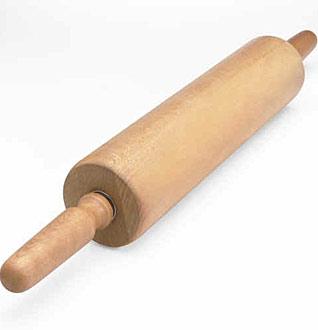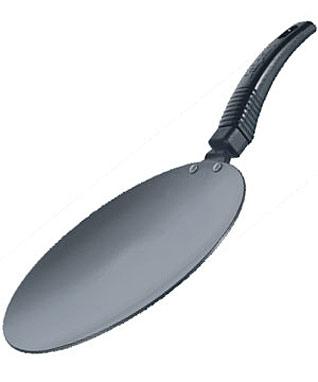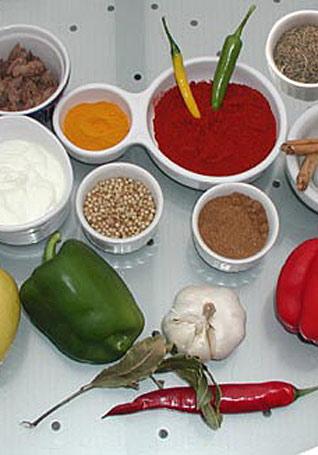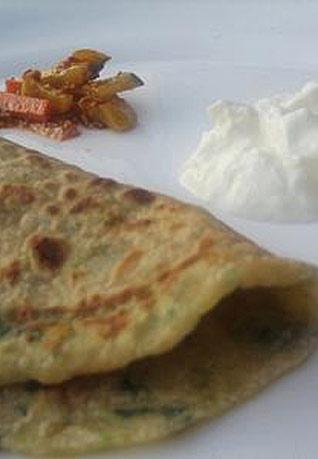Columnists
Methi di Roti
by MEETA KAUR
Sometimes, our kitchen spills over with the comforting aroma of traditional Punjabi masala - fried onions, ginger, and garlic - that we use for an occasional daal or a sabzi and for which we prepare the traditional accompaniments of yogurt and a plate of fresh vegetables, soaked in lemon juice.
Growing up in a Punjabi household, I'm keenly aware of which main dishes go with either a roti or rice, so I often wonder why the roti has become an endangered edible in our home. Somehow, we have settled for pairing saag, baingan, and gobi with a bowl of basmati rice. Most of the cooks in my family would consider this a form of suffering, so the silent resistance to making our rotis, while secretly being committed to obtaining them in any way possible, is worth some attention.
On weekends, we find it perfectly reasonable to schedule our Sunday morning for drives to Vik's Chaat House in Berkeley, to pick up a half-dozen packages of rotis, before they all disappear with the early lunch rush. Or, we will drive to my mom's house, so we can stock up on a month's supply, to haul them back to our home and store in our freezer.
To be fair to my brother, my mother will prepare 50-60 rotis and pack them in his suitcase when he comes to visit, so he can fly back with them to his home in Illinois and secure them in his freezer. Or, she will Fed-Ex him stacks of tightly foil-wrapped frozen rotis, so that they survive the trip, only to be re-frozen.
All of this wrapping, packing, shipping, and freezing have become normal routines for us as a family. It's almost too normal. All of this effort, just to have rotis sitting side-by-side with meat and vegetables on our dinner plates, is an indication of something going awry.
I have been ruminating over why I resist making my own rotis. I'll make batter and dough for pancakes, brownies, cookies, cakes and banana bread. So, why not aata?
I wonder if I have subconsciously relegated roti-making to an antiquated practice in an otherwise modern world. I remember watching one of my cousins in Punjab squatting next to a tavaa (hot-plate), slapping together two dozen rotis for a dinner, and thinking I'd only be able to squat long enough to place the first one on the hot-plate.
So, I simply eliminated roti from my list of must-learn items.
I do question my ability to gun aata, to knead the wheat flour with water, but without a recipe! And to shape perfectly round peras and roll out rotis that are appetizing, appears to be a daunting task.
Past attempts have produced geographical representations of Florida and Texas, but is that really an excuse to not try again?
I've landed on childhood memories as an obstacle to our own roti-making efforts. The nostalgia of receiving a tavaa-made roti, dripping with butter, from my mother's hands, has enough sentimental value to override any current practicality of making my own. And like many immigrant mothers, mine has earned her position as a proud Punjabi woman in America by mastering everything roti, so that there's a lot to live up to.
Over the years, she has made countless versions of the roti - chappati, tandoori, makki, naan, kulcha, poori, and every variation of the parantha - aaloo, daal, gobi, paneer, methi - countless times.
She has experimented with methi paranthas enough to create a 21st century super-food by adding baysen, daal, low fat ricotta cheese and methi, packing every daily nutrient needed into every single bite.
The feeling of fullness, satisfaction and contentment that comes from rotis, with my mother offering seconds while commanding us to "raj-ke khaa-o!" ("eat till you're satisfied") are emotional family heirlooms I'd like to pass down to my own daughter and future children.
Nothing says "home" like a roti made by Mom. And the comforts of this daily staple from a mother's kitchen, fully exceed anything bought from a chaat house, or eaten in a restaurant.
To act on these chapatti daydreams, I'll start with a baby paronthi with masala chicken or daal for my daughter, and then move on to choorie - bits of a parantha, mixed with butter and brown sugar - making it myself and hand feeding it to her until she is full, satisfied and content.
Recipe for Methi Parantha dough:
Mix the following items until they form a cookie-type dough:
1 cup of baysen
1 cup of cooked maah-di-daal, dhoti (washed)
1 cup of methi (and cilantro, optional)
½ cup of low-fat ricotta cheese
½ cup of freshly-cut onions
3 tablespoons of olive oil
1 teaspoon of chopped green chilli
salt, to taste
enough wheat flour to bind the dough together
water, if needed
Conversation about this article
1: Jessi Kaur (California, U.S.A.), July 18, 2007, 2:00 AM.
"Methi di Roti" reminded me of my early days in Northern California when there were no packed roties available - no Vik's Chat House or other establishments that made fresh roties for newly-wed housewives who had never before entered kitchens but now had the task of running a household on their hands! I faced the same paradox about having fond memories of a freshly puffed up phulka, served straight from the tavaa, but also a reluctance to make atta and roties! For years, an electric dough-maker did the job and even then I waited for my husband to come home and make the phulkas while I had the dal, sabzi and other accompaniments ready. He had taught me to cook but I had drawn the line at making the atta and roties. Meeta, I totally understand your reluctance! Even today, I can cook up a storm when I entertain, but we order the naans or paranthas from the neighborhood restaurants. The phulka problem was solved when a Chinese housekeeper learned to make wonderful fresh roties!
2: Jessi Kaur (California, U.S.A.), July 18, 2007, 2:13 AM.
Meeta, your Mom's methi parantha sounds scrumptious. I will pass on the recipe to my mother-in-law, with a request to try it out. She has taken on the task of making roties in our household now!
3: Supreet Dhillon (Chicago, U.S.A.), July 18, 2007, 11:54 AM.
I share your sentiments, Meeta. You are so lucky to have your Mom close by. Some poor souls are dying to taste Mom's khaana ... yours truly included! Anyway, loved reading your thoughts. Good job!
4: Parminder Kaur (Raleigh, NC, U.S.A.), July 18, 2007, 9:59 PM.
Great, I cannot wait to taste your Methi di Roti! Benanti will love the choori. What is it that makes us avoid making fresh roti? Is it the mess we have to clean up later, or is it that the one making the roti is the last one who gets to eat, for every one wants it fresh off the tavaa?
5: I.J. Singh (New York, U.S.A.), July 20, 2007, 7:08 AM.
I am tempted to revisit my first few years in this country and my dsisastrous attempts at learning how to cook. I mastered the art rasonably well, but not that of roti-making. For about 30 years in the U.S., I had no access to good Punjabi cooking, and your lovely essay brought back memories of that time - both good and some that were not so good. Fantastic essay.
6: Manbir (London, U.K.), July 20, 2007, 4:44 PM.
It is the mess that you have to clear up afterwards! Especially if you part-cook the phulka on the naked flame, instead of the tavaa. Having said that, I have started making roti and paranthas more regularly since I have had my two children, so that they too can have memories of fresh roti/parathas from the tavaa, straight onto their plate, when they are older.
7: Manjit Singh (U.S.A), July 20, 2007, 5:25 PM.
I think some people just have a mental block about making roties. Actually, it is not hard or time-consuming at all. Being married to a non-Punjabi woman and watching my mother cook roties everyday, three times a day all her life, I have learned to appreciate more of my mother and her cooking than ever before. Feel blessed that I am able to whip out a few roties for the whole family quickly, even though we don't cook Indian food every-day three-times-a-day that I grew up with. Roti- and sabzi- making is an art form! And you have to have fun doing it!
8: Jesica (U.S.A.), July 20, 2007, 7:04 PM.
Very warmly written. It has rekindled my taste buds, and makes me yearn once again to eat food from mom's hands, which are always oozing with warmth and love for her children. Hope everyone enjoys your recipe ... Yummy ;-) Chak De Phatte!
9: Rani (West Midlands, U.K.), July 20, 2007, 8:49 PM.
It has been a pleasure to read this article and, like with many of the others, it brings back so many sentimental memories. I am 44 yrs old and was born in the U.K. I have had a good upbringing, having lived with my grandparents and extended family, and brought up in the Sikh way of life. I have been fortunate in having learnt cooking from two generations of mothers. I have had the best of both worlds and can honestly say that there is nothing more satisfying than Punjabi cooking, with a freshly made roti/paratha, straight from the tavaa. The mere thought of it makes my mouth water, as I write this. Compliments to the author.
10: Jaswant K. Singh (Sacramento, U.S.A.), July 20, 2007, 11:34 PM.
Punjabi food is never complete without roti. Thanks for the mouth-watering recipe for methi di roti. I will enjoy it with my family.
11: Harbhajan Singh (Baton Rouge, Loiusiana, U.S.A.), July 20, 2007, 11:47 PM.
Why go through all this dedication? It is tough enough to make phulkas or rotis: forget them being perfectly round, they always turn out to be odd shaped. Best is to dig in with paranthas ... with minimum oil or ghee, keeping an eye on your cholestrol levels. There will always be some ladies who will make rotis and paranthas for the singles. We have a gathering of the kids and grand-kids over the Christmas holidays, and we do get lots of such help on "manufacturing" them in bulk, so that we can stock up for times to come. O, there are so many short cuts in life!
12: Punjabi Singh (Philadelphia, U.S.A.), July 21, 2007, 8:15 AM.
"Methi di Roti" brings to the fore a ubiquitous phenomenon amongst Punjabis living in the diaspora. We want to enjoy all the Punjabi food without having to cook it ... looks like we've been well spoiled by our mothers.
13: Kuldip S. Gurwara (Dubai), July 21, 2007, 11:36 AM.
Roties are the best. But, nothing beats the parshadaas served in the langar at Harmandar Sahib!
14: Rathna (Oxford, Ohio), July 21, 2007, 3:41 PM.
Well I don't know why all the fuss about making rotis ... I am a student here and my roommate is from Punjab and I get these yummy rotis - plain and stuffed with aaloo, methi, onions and chillies, ajwain ... you name it and I have had it! And, just to mention, she is doing her doctoral program in neurosciences. Everyday, yes, everyday, she makes them tirelessly. Two, or sometimes, even three times a day. And she loves to make them for me, too. Hot, delicious, full of butter, if I want it that way. If I remember correctly, it started with her mom giving her directions over yahoo-chat the very first week she was here from India! As to how to prepare it ... wow, I should say then, hats off to you! You rock and should be proud of yourself!
15: Devakaur Khalsa (Orlando, Florida, U.S.A.), July 22, 2007, 12:16 AM.
Though my mom did not make roti, you have me craving them! One day soon, I will try making the Methi rotis!
16: Rimmi Uberoi (U.K.), July 22, 2007, 2:59 AM.
I have been making methi di roti for quite some time but find it nicer with masoor daal, and for ordinary everyday roti, when I knead the aatta, I add a spoonful of oil and knead with warm water as I have arthritis and it makes the aatta easy to roll.
17: Kulwant (London, U.K.), July 22, 2007, 5:26 AM.
I am originally from Mombasa, Kenya, where I was born and brought up with all types of rotis and parathas. We had an outdoor tandoor where a woman made the rotis for the neighbourhood after recieving the aatta peraas supplied by each household. We moved to London in 1974 but have continued with the same old rotis/parathas and tandoori missi naans. (Portable tandoors are available here.) In fact, here in London (Southhall/Wembley), with thousands of Sikhs and other Indians here, there is nothing you cannot have. The Punjabi TV programs show you old and new recipes. And both the London Gurdwaras and restaurants provide you with the best! Unfortunately, 80% of the Punjabis who are regular aatta eaters are going around with big pot bellies and diabetes, all of which gets further complicated by the lack of excercise. As a result, doctors do not recommend these rich rotis and parathas any more, and restrict them to once a week ... on Sundays, if we are lucky.
18: Jasbir (England), July 22, 2007, 7:24 AM.
Mum's cooking is the best. I grew up in Kenya. My parents are still there. Eating rotis three times a day, we never got fed up with that. Sometimes, mum would also put shukker in the paranthas and we would eat them with lots of butter. I do make all types of rotis for my family now but still crave mum's makki di roti, with raddish in it. Yummmmy!!
19: Manpreet (Melboure, Australia), July 23, 2007, 12:00 AM.
That was a brilliantly written piece. I didn't ever realize that torture and delight could be so strongly intertwined until I read "Methi di Roti". Couldn't wait to finish reading your piece. And couldn't gulp fast enough to push the saliva away from my taste buds, which were gasping for Mum's paranthas (haven't had them for two years now!) And since I read the piece while I was at work, I couldn't even make an apology of a parantha right then to placate the senses. It was torture at work that day. I rushed home and finally got to make a nice namak-ajwain parantha, with the customary dripping-butter on top. Nothing like Mums' cooking, though ... but it'll have to do till I meet her in November this year. But, thanks for reminding me that it's the littlest things in life that are the most important, the tiniest memories that appear to be the most significant, and the minor indulgences that somehow bring the greatest satisfaction.
20: Paramjit Grewal (Macungie, Pennsylvania, U.S.A.), July 23, 2007, 9:27 AM.
Along with "rujj-ke-khaa", I also teach our sons to "dub-ke-vaah" (work hard). Here in Pennsylvania, we do some "vaahi" and grow our own methi which my wife turns into great methi di roti, or "green roti", as our sons used to call it. Great article.
21: Rajdeep Kaur (U.S.A.), July 23, 2007, 9:50 AM.
Wonderful piece, beautifully written! Some tips on overcoming the mental block to making rotis: 1. Do yourself a favour - buy a Kitchen Aid Stand mixer to gunno fresh aatta in less than 5 minutes. Also, buy the Grater attachment. It's superb for grating gobi and mooli for stuffed paranthas. I've had my aatta machine for almost 10 years now and and it's served me very well. 2. Set up your workspace to minimize excuses! Have sukka (dry) atta ready in a separate box. Store it together with your tavaa, chaklaa and velnaa. 3. Don't aim for perfection! So, go ahead and make your Texas or Florida map. One whiff of the heady aroma wafting from your kitchen and they won't even notice the shape. 4. Velo the last 2 rotis/paranthas and then have your husband or kids cook them for you. This way, you too can enjoy the 'fresh-off-the-tavaa' rotis you just fed your family :) 5. When time permits, allow your kids to experiment with their own creative versions and let them cook it themselves. My boys, 6 and 8 years old, love to do it and it only takes 10 minutes. And next time you meet your mom, surprise her by cooking fresh rotis for her!
22: Harinder Tagore (Baltimore, U.S.A.), July 25, 2007, 9:53 PM.
Methi di roti is much more delicious when cooked by your mom and served with all the love and care: you actually end up eating more than you need! I'm lucky to have such a mom. Enjoyed reading your wondeful article.
23: Inderjit S. Sawhney (Jackson, New Jersey, U.S.A.), July 26, 2007, 5:25 AM.
There is something magical about the 'rotis'. I was looking at the recipes mentioned above. The one ingredient missed out was the 'deep love' for your loved ones, which you need to mix with the other ingredients before one can be sure of great rotis. The 'rujj ke khaa' and the 'take more' of a mother are what make the rotis/meals unforgettable. I still remember the meals had at my Bhabiji's (naani's) home and also at my maasiji's home, where it used be something more than the taste of food that we used to enjoy. The Indian restaurants can. of course, serve delicious food to you but there will always be a missing ingredient, which one will always crave for, if one has had the meals prepared with love in one's yesteryears. I am not a good cook but 'try' to cook for the ones I love and can feel the satisfaction one gets by loving and caring. I will now make it a point to cook for my jhaiji (mom) next time she is with me.
24: Kamal (U.S.A.), July 26, 2007, 9:25 AM.
I think it is a matter of taste and your own food standards. My mother used to work full time and still would cook roti and various food dishes fresh and from scratch everyday. Now that I have my own family, I make roti, paranthas, puri and everything fresh. I have tried to freeze or buy them ready-made. It just doesn't taste the same. It might be time-consuming, but if taste is what matters most, then it is worth all the effort. Since you are spending time in the kitchen making the main dish, you might as well cook roti on the side too.
25: Kamal (U.S.A.), July 26, 2007, 9:32 AM.
With left-over roti, the next day you can make delicious "pizza": just sprinkle on to the plain roti the following: chopped onion, green chilli, add ham or chicken, grated cheese and salt or chaat masala. Put in the microwave for 1.00 min or until cheese has melted. Voila. Bon Appetit!
26: Kanwal Nain Singh (Lindsay, Ontario, Canada), August 12, 2007, 11:07 PM.
It is very interesting to read Meeta Kaur's story on 'Methi di roti'. More facinating was the response from the readers. While roti itself is fine, many who responded to your column relishing the paraanthas must watch out for excessive intake of butter fat. Meeta's recipe is very simple and contains healthful ingredients. But, alas, I have a problem. Many memebers in my family are allergic to gluten. Although Besan is allowed, aata is not. Those who are ciliacs know that they cannot tolerate even a miniscule amount of atta. I am wondering if Meeta or someone could suggest a substitute for aata as a binder. Would white of an egg do the trick? My family is even hesitant to use the Indian besan because it contains some flour as a binder. Help.
27: Meeta Kaur (California, U.S.A.), August 13, 2007, 12:24 AM.
Dear Kanwal, I understand the sensitivity to gluten; I'm looking into it myself these days. I suggest rice flour or buckwheat flour. If you do try binding it with the white of an egg, you can always add more basin to soak up any excess moisture the egg brings into the mixture. If I come up with any other ideas, I'll write in. Thanks for your question - it's a good one.
28: Amina (Toronto, Ontario, Canada), August 27, 2007, 2:34 PM.
I'd love to make this parantha, but what is the "1 cup of cooked maah-di-daal, dhoti (washed)" - can you please explain what you call it in English so that I know what to get when I go to buy groceries.
29: Kalwinder (Sacramento, California, U.S.A.), December 26, 2007, 2:06 AM.
Frozen rotis? That's pitiful ... if you can open a can of that nasty processed food, then you can certainly make roti from scratch; it takes less than five minutes and it isn't rocket science, people!
30: Jaswant Singh (Toronto, Canada), January 27, 2008, 4:47 PM.
In my opinion, food is an integral part of culture. Someone in this forum said it right: we owe it to our kids to give them sweet memories of childhood. They can buy everything in their life except for simple, fresh home-cooked food. My wife and I are both professionals, but we never miss complete home-cooked meal at dinner time. This consists of roti, daal, subzi and dahi. On weekends, we go a little further by cooking other Indian foods like South Indian or Gujarati fare. Our kids love that. Now they are used to both types of food, Eastern and Western, spicy and mild. They sometimes enjoy making small rotis with our help. It is not difficult. One of our Chinese friends who likes roti very much has learned to cook it and makes dahi at home too.






